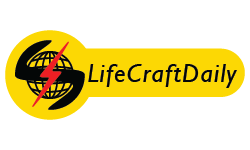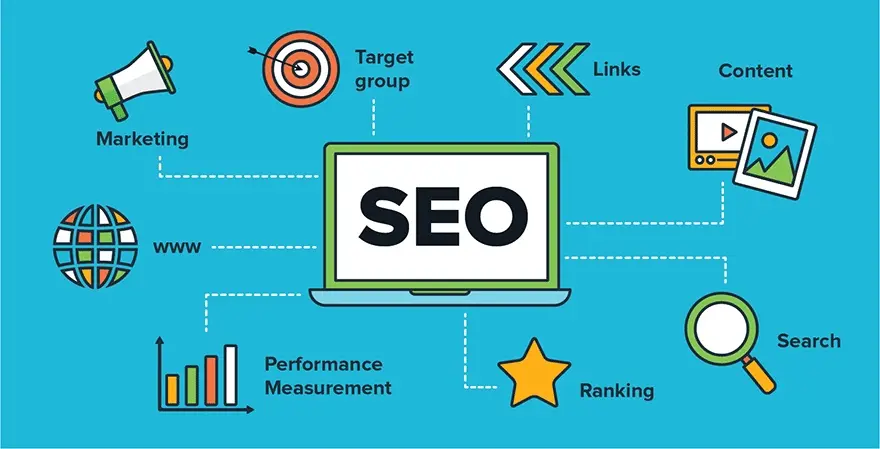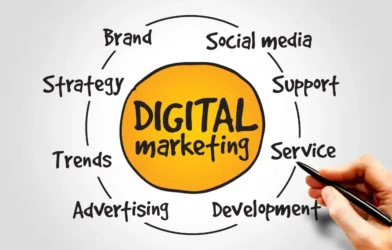SEO Title, Search Engine Results Pages (SERPs) greatly affect website optimization. Unfortunately, few companies know how to leverage them for maximum viewer attraction. With these seven tips for crafting clickable SEO titles, you can boost readership and rank higher on Google SERPs.
What Is SEO Title Tag in HTML?
SEO titles appear at the header or metatag levels on web pages. They direct search engine crawlers to relevant pages and improve SEO campaign performance.
Inform Search Engines and Readers
Your metadata informs search engines and readers about your page content. It appears on user tabs for easy recognition and navigation.
First Impression
SEO titles serve as the first impression when people search online.
Enhance CTR
SEO titles can increase click-through rate (CTR) and drive traffic to your website. To identify an SEO title, look at the page’s tab or right-click to view the HTML tag.
SEO Title Vs. Page Title
Both titles are essential for content marketing. However, page titles usually don’t show up in Google SERP or user tabs. They refer to H1 tags on pages.
Example: For blog posts on SEO best practices, an engaging page title might be “Top 10 SEO Best Practices of 2023.” Your SEO title could be “10 Proven SEO Tips in 2023 (That Will Help You Rank High).” Both titles capture attention and promote higher CTR.
Issues When Writing SEO Title Tags
Writing click-worthy SEO titles might seem easy, but common mistakes include:
Too Many Buzzwords
Overuse of keywords can prevent an SEO title from ranking well in SERPs and confuse readers.
Too Long
Google supports titles up to 60 characters long. Any longer won’t appear correctly in search results.
Without Keyword Research
Failing to conduct keyword research can be costly. Search engines won’t understand your content, and competing pages with correct tags will outrank you.
Why Click-Through Rate (CTR) Matters in SEO Title
CTR measures how many viewers clicked your result when it appeared in SERPs. An engaging title can boost CTR and attract new viewers. Google recognizes higher CTR and ranks your title higher with each click.
How to Write SEO Title Tags for Maximum Results
Now that we understand why SEO titles are essential, here are seven strategies for crafting effective titles:
1. Utilize Primary Keywords
Primary keywords must be included in an SEO title tag for optimal content presentation. For example, using “SEO tips” in your title is ideal. Tools like Google Keyword Planner, Ahrefs, SEMrush, and Moz Keyword Explorer help find relevant keywords.
Keyword Research Tools
To successfully use primary keywords, extensive keyword research must take place. Here are a few popular tools you may wish to consider for this process:
Google Keyword Planner offers keyword ideas and traffic estimates while Ahrefs provides in-depth keyword data and competitor analysis. SEMrush can assist with keyword research, tracking keyword strategies, and more while Moz Keyword Explorer specializes in finding low competition but high traffic potential keywords.
Once You Identify Primary Keywords
Once your primary keywords have been determined, incorporate them naturally into your SEO title. Keyword stuffing can be detrimental; strive instead for a balance so the keyword integrates smoothly within its context of use within the title.
2. Utilize Longtail Keywords
Longtail keywords help reach a targeted audience and increase CTR. For instance, “Best apples for making pies” is a good longtail keyword. Tools like Google Suggest, Answer the Public, and Ubersuggest help find longtail keywords.
Discover Longtail Keywords
Longtail keywords are specific phrases composed of three or more words that make up specific searches, making it easier than ever before to locate these terms. Here’s how:
Google Suggest: Simply start typing your primary keyword in Google’s search bar to see its suggestions.
Answer the Public: Discover related questions and phrases about it; while Ubersuggest provides longtail keyword ideas along with search volume data and competition analysis.
Benefits of Longtail Keywords
Longtail keywords often face less competition, making it easier to rank for them and draw in qualified traffic because they target specific search intents. For instance, someone searching “best apples for baking pies” will probably want more specific details than someone searching simply “apples.”
3. Keep SEO Title Length and Width in Mind
Google provides an optimal length threshold of 50-60 characters when considering SEO titles; anything longer will get cut off by search engines’ SERPs and could have negative repercussions for CTR and viewer accessing all your content.
Tools to Check Title Length
There are various tools that can help ensure that SEO titles have the appropriate length:
Yoast SEO Plugin provides real-time preview of how your title will appear in SERPs (Search Engine Results Pages).
SEO Mofo Preview Tool lets you enter in your title to test its appearance on Google search engine results pages.
SERPSim simulates search engine results to preview title and meta descriptions.
4. Leverage Branding
Including branding in your titles increases recognition and click-through rates. For instance, “Top Ten Baking Tips by Baking Delight” integrates branding naturally.
Benefits of Branding in SEO Titles
Branding SEO titles is beneficial in creating brand recognition and trust among your audience members as it increases click-through rates as these users will more likely select content featuring your brand name.
How to Incorporate Branding
Integrate branding naturally within SEO titles. For instance, if your brand name is “Baking Delight,” an appropriate title might include something such as: “Top Ten Baking Tips by Baking Delight.” Ensure that this title still reads well and adds value for its readers.
5. Use Emotion-Striking Words
Emotion-provoking words like “inspiration,” “amazing,” and “outstanding” can drive emotional responses. Yoast SEO found adding power words increased traffic by 30%.
List of Effective Power Words
Here is a list of effective power words you can use in titles to add impact:
- Inspiration: Provides motivation and positivity.
- Amazing: Facilitates amazement and curiosity.
- Outstanding: Emphasize excellence and superiority.
- Ultimate: Assume fullness and comprehensiveness.
- Proven: Reflect reliability and trustworthiness.
6. Consider Numbers and Lists
People love listicles as they’re easy to digest. Including numbers in your title, like “15 Amazing Apples for Baking,” hooks readers.
Why Numbers Work
Numeric content sets clear expectations for readers. Readers know exactly what to expect and can quickly scan over it; hence why titles with numbers often outperform competitors in terms of click through rate (CTR).
Example Titles for List-Based Titles
- “10 Proven SEO Tips for 2023”
- “7 Amazing Travel Destinations in 2024”
- “15 Effective Home Workouts (You Don’t Require Equipment)”
7. Measure CTR
Monitor CTR using Google Analytics, Google Search Console, or SEMrush. Use data to refine your titles and improve performance.
Tools for Measuring Click-Through Rate (CTR)
There are various tools that can help you measure CTR and assess how effective your SEO titles are:
Google Analytics: Track your site traffic and user behavior.
Google Search Console: Offer insights into search performance including CTR for individual pages.
SEMrush: Offer detailed reports about site performance including CTR metrics.
Improving CTR Based on Data
Once you have data about your clickthrough rate (CTR), use it to refine SEO titles. Experiment with different title structures, keywords, and power words until your CTR meets its desired levels. Then monitor results until reaching optimal performance!
Advanced Strategies for SEO Title Optimization
While these seven tips represent essential building blocks of title optimization efforts, more advanced tactics may also prove invaluable in further optimizing it. Such techniques involve understanding user intent more profoundly, taking advantage of analytics data sources, and conducting ongoing tests.
Understanding User Intent
Search query intent can provide us with valuable information for crafting SEO titles which meet user desires directly. Understanding it allows us to write titles which specifically meet their search queries.
Types of User Intent
Informational Intent: Users seek knowledge about a topic (e.g. “how to bake an apple pie”).
Navigational Intent: Users seek to visit specific websites (e.g. Facebook log-in page).
Transactional Intent: Users want to purchase something (e.g. “buy baking apples”).
Crafting Titles Based on Intent
Optimize SEO titles according to user intent for greater relevance and click-through rates. For informational intent, titles like “How to Bake an Apple Pie: Step-by-Step Guide” could work, while transactional intent calls for something like “Buy the Best Apples Online.”
Leveraging Analytics for Continuous Improvement
Analytics tools like Google Analytics and Search Console offer invaluable data that shows how users interact with your SEO titles.
Key Metrics to Track
Click-Through Rate (CTR): Indicates how many users click your title in SERPs.
Bounce Rate: Indicates how many visitors leave after viewing only one page on your site, indicative of unengaged traffic.
Average Time on Page (ATTP): Provides insight into engagement on pages as measured by measures like Avg Visit Time or Average Visited Time per Visit (AVTV).
A/B Testing SEO Titles
An A/B test involves creating two versions of an SEO title and comparing their effectiveness to determine which version will prove more successful.
How to Conduct A/B Tests
- Establish Two Variants for Similar Content
- Split Traffic: Utilize tools like Google Optimize to divide traffic evenly amongst both titles.
- Analyze Results: Evaluate results by measuring CTR or any other performance-related metric.
- Implement the Winner: Make use of your best performing title as your permanent SEO title.
Case Studies for Successful SEO Title Optimization
Investigating successful case studies can give insight into effective title optimization strategies.
Case Study 1: HubSpot
HubSpot optimized their blog titles to increase CTR and engagement for maximum traffic. By including key words and numbers with regard to user intent and engaging writing style, HubSpot saw significant traffic gains.
Example Titles
Before: “How to Improve SEO”
After: “10 Proven Strategies That Experts Advise on”
Case Study 2: Neil Patel
Renowned digital marketer Neil Patel uses SEO titles with strong hooks in them to attract readers. His approach involves employing longtails keywords along with numbers in his strategy for reader attraction.
Example Titles
Before: “Guide to Content Marketing”
After: “The Ultimate Guide to Content Marketing in 2023 (Step-by-Step)”
Case Study 3: Moz
Moz optimized its SEO titles by prioritizing primary keywords and user intent. They used analytics tools to continuously refine them.
Example Titles
Before: “SEO Basics: Optimizing Your Site for Search Engines”
After: “Master SEO Basics: Your Guide to Optimizing Your Site for Search Engines”
Avoid Mistakes in SEO Title Optimization
Even with the best strategies and planning in place, certain mistakes may thwart your efforts at title SEO optimization. Avoiding these potential pitfalls is essential for maintaining high CTRs and search rankings.
Keyword Stuffing
Keyword stuffing occurs when an author fills their title with too many keywords that appear unnatural or spammy, leading search engines to penalize the site.
Example of Bad Keyword Stuffing
“10 Best SEO Techniques of 2023”
Example of Good Keyword Integration
“10 Most Valuable SEO Tips and Practices in 2023”
Clickbait Titles
While clickbait titles might attract clicks initially, they often lead to high bounce rates and decreased trust among your visitors. Ensure your titles accurately represent the content on your pages.
Example of Clickbait Title
“You Won’t Believe These SEO Tips!”
Example of Effective Title
“Effective SEO Tips That Should be Considered”
Ignoring Mobile Users
An increasing percentage of searches originate on mobile devices. Make sure your titles are mobile-friendly by keeping them concise and designed to display properly on smaller screens.
Not Updating Titles Regularly
SEO is an ongoing process. For sustained success, regularly revamping SEO titles in line with trends, keyword performance, and user behaviors is paramount.
Example of Title Update
2023 Title: “Top SEO Tips of 2023”
2024 Title: “AI-Powered SEO Tips of 2024”
Tools & Resources for Title Optimization
While optimizing titles effectively is no simple feat, tools are available that can assist with optimizing them successfully.
Title-Generating Tools
- Title-Generator.com: Generates multiple title suggestions based on keywords you enter.
- SEOPressor Blog Title Generator: Supplies creative yet optimized title ideas.
Keyword Research Tools
- Google Keyword Planner: Uses keyword suggestion tools to help discover relevant keywords and their associated search volumes.
- Ahrefs: Provides in-depth keyword data and competitor analysis.
- SEMrush: An all-inclusive keyword research and SEO analysis platform.
Analytics Tools
- Google Analytics: Tracks website traffic and user behavior.
- Google Search Console: Provides insights into search performance and click-through rates (CTR).
- Moz Pro: Offers SEO analytics and keyword tracking solutions.
Conclusion
Optimizing SEO titles is key to increasing website traffic. By employing both primary and longtail keywords, keeping titles concise, using branding terms like power words or numbers/lists for rankings purposes and continuously refining them over time, creating compelling headlines with strong SEO values that stand out can boost rankings while drawing clicks. Align your titles with user intent while taking advantage of analytics for continuous improvements and avoid common blunders to achieve the best possible outcomes.





